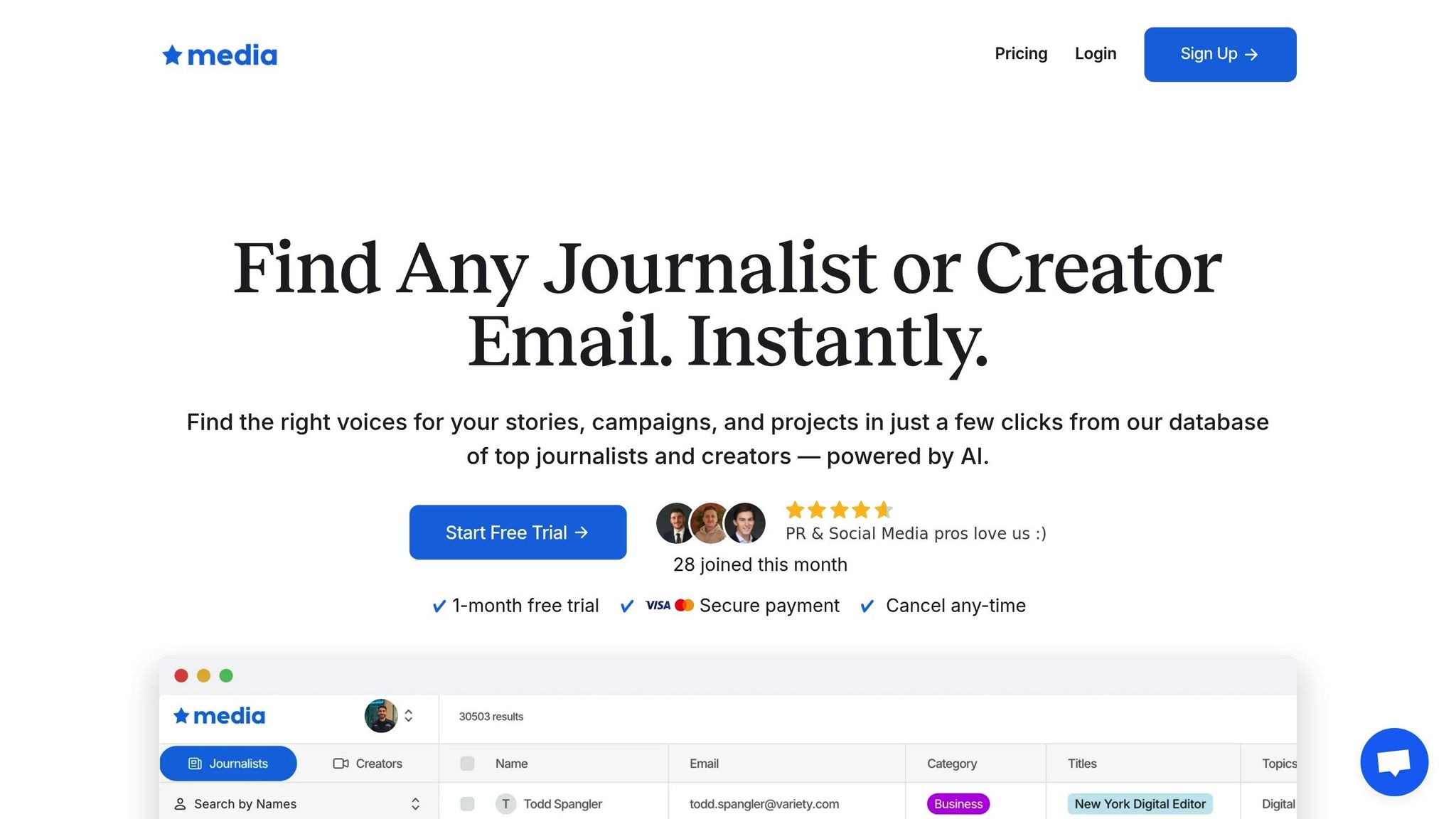How AI Tracks Stakeholder Sentiment in PR
Explore how AI enhances PR teams' ability to track stakeholder sentiment, offering insights for effective communication and crisis management.

AI is transforming how PR teams monitor stakeholder sentiment, offering faster and more accurate insights than manual methods. By analyzing text from sources like social media, news outlets, and customer reviews, AI tools help organizations:
- Spot issues early: Detect negative sentiment before it escalates into a crisis.
- Measure success: Evaluate campaign performance in real-time.
- Tailor messaging: Customize communication based on audience preferences.
- Act globally: Analyze sentiment across languages and regions.
Natural Language Processing (NLP) enables AI to interpret context, tone, and even sarcasm, providing a deeper understanding of emotions. Tools like Media AI also link sentiment insights to media outreach, helping PR teams respond quickly and effectively.
AI’s real-time and historical analysis capabilities support both immediate actions and long-term planning, making it a critical asset for PR strategies. However, blending AI with human expertise ensures more accurate results, especially when dealing with nuances like sarcasm or fragmented language.
AI: Sentiment analysis in 2025 - Maha Global's Darwin

How AI Tracks Stakeholder Sentiment
AI sentiment tracking helps businesses understand how stakeholders feel about their brand by analyzing text data. This technology scans various digital sources and uses algorithms to interpret emotions and opinions expressed in written content. Here's a closer look at how it works and where it gathers its data.
Data Sources for Sentiment Analysis
AI tools pull opinions from a wide range of digital platforms, each offering unique insights into stakeholder sentiment:
- Social Media: Platforms like Twitter, Facebook, and Instagram generate massive amounts of content daily. These posts often capture real-time reactions to brands, products, and services, making them a goldmine for sentiment analysis.
- News and Media: Monitoring news outlets, industry publications, and online magazines allows AI to track how media professionals discuss your organization. This can help spot potential reputation risks early.
- Online Forums and Communities: Sites like Reddit, Quora, and niche industry forums host open discussions where people share unfiltered opinions. These detailed conversations provide valuable context beyond what social media posts typically offer.
- Customer Review Sites: Platforms such as Yelp, Google Reviews, and Glassdoor feature structured feedback that AI can analyze to categorize stakeholder sentiment.
- Blogs and Comments: Blog posts and their comment sections often include longer, more detailed opinions, giving AI tools additional depth to analyze.
- Internal Communications: Emails, survey responses, and customer support tickets also contribute to sentiment tracking. However, integrating these sources often requires connecting AI tools with internal systems.
Natural Language Processing (NLP) and Sentiment Detection
At the heart of AI sentiment analysis is Natural Language Processing (NLP), which enables machines to interpret human language in all its complexity. This goes far beyond simple keyword detection, helping AI understand context, tone, and even subtle emotional cues.
Using pre-trained machine learning models, AI can identify patterns that indicate positive, negative, or neutral sentiments. These models can pick up on emotional hints like enthusiasm, frustration, or disappointment - even when those feelings are expressed indirectly.
Additionally, AI can gauge the intensity of sentiment. For example, it can differentiate between mild dissatisfaction and strong discontent or recognize the difference between casual approval and outright excitement. This level of detail helps PR teams understand not just whether the sentiment is positive or negative, but how strongly stakeholders feel about specific issues.
For global brands, multi-language processing is a game-changer. AI can analyze sentiment across different languages and cultural contexts, accounting for regional expressions and nuances. This capability ensures a more accurate understanding of stakeholder emotions worldwide.
Real-Time vs. Historical Sentiment Analysis
AI tools can analyze sentiment in two key ways: in real-time or over longer periods.
- Real-Time Analysis: This method processes data as it comes in, offering immediate insights into stakeholder reactions. It's particularly useful for crisis management, where detecting a spike in negative sentiment quickly can help PR teams respond before the situation worsens. Real-time monitoring also benefits social media campaigns by allowing teams to adjust messaging, engage audiences, and ride the wave of positive reactions as they happen.
- Historical Analysis: This approach looks at data collected over longer periods, with updates typically happening daily or hourly. It’s ideal for identifying trends, seasonal patterns, and the long-term effects of PR campaigns or corporate decisions.
Both methods serve unique purposes. Real-time analysis is crucial for immediate responses, such as managing crises or engaging in live social media interactions. On the other hand, historical analysis helps with long-term planning, campaign evaluations, and spotting trends over time.
Successful PR teams often combine these approaches. Real-time insights guide quick tactical actions, while historical analysis shapes strategic decisions and tracks long-term progress.
Steps to Implement AI Sentiment Tracking in PR
AI sentiment tracking can help you better understand your audience, improve engagement, and drive actionable insights. Here's how to implement it effectively.
Identify Key Stakeholder Channels
Start by figuring out where your stakeholders spend their time and express their opinions. Focus on the platforms that align with your audience and business goals.
Group your stakeholders and review existing touchpoints like website analytics, social media interactions, and customer feedback. Different groups tend to favor different platforms. For example:
- Customers may voice concerns on Twitter or review sites.
- Industry professionals often share insights on LinkedIn or niche forums.
Pay attention to the context and format of each platform. Twitter is great for real-time reactions, LinkedIn offers thoughtful professional commentary, and Reddit provides candid, in-depth discussions. Each channel offers unique opportunities for sentiment analysis.
Don’t overlook industry-specific platforms. For example:
- Healthcare companies should monitor medical forums.
- Tech startups might track GitHub or Stack Overflow.
- Financial services firms can find sentiment data in investment forums or financial news comment sections.
Once you’ve mapped out the key channels, choose AI tools that can efficiently analyze sentiment across these platforms.
Choose the Right AI Tools
Picking the right AI tools involves balancing features, budget, and compatibility with your current PR systems. Look for tools that deliver accurate sentiment analysis and integrate smoothly with your CRM, social media management, and reporting tools.
Here’s what to prioritize:
- Core features: Ensure the tool supports multiple languages (if applicable), understands industry-specific terms, and offers detailed sentiment scoring - beyond just “positive” or “negative.” Advanced tools can detect nuances like sarcasm and emotional intensity.
- Additional capabilities: Some platforms, like Media AI, go a step further by linking sentiment data to media outreach. For instance, you can identify positive trends and connect with relevant journalists to amplify the story - or quickly reach out to trusted contacts during a crisis.
- Scalability and costs: Factor in upfront expenses, training time, integration costs, and ongoing maintenance. Choose a solution that can grow with your needs.
Once your tools are in place, the next step is turning data into action.
Analyze Sentiment Trends and Take Action
Sentiment data is only as good as the insights you draw from it. Focus on identifying patterns and creating response strategies.
Start with a baseline. Document current sentiment scores across your key channels and stakeholder groups. This gives you a reference point to measure future changes and spot significant shifts.
Track trends over time. Weekly or monthly analysis often uncovers patterns that daily monitoring misses. Look for correlations between sentiment changes and specific events. For example:
- Did positive sentiment spike after a product launch?
- Did a competitor’s campaign impact your audience’s perception?
This kind of analysis helps you pinpoint which PR activities are effective and which need adjustment.
Develop response protocols. Set clear thresholds that trigger specific actions. For instance, if negative sentiment rises by 20% in 48 hours, initiate a crisis response plan. Having these protocols in place ensures your team can act quickly and consistently.
Prioritize responses based on intensity. A handful of highly negative mentions from influential voices may require more immediate attention than a larger volume of mild criticism from less impactful sources. This approach ensures your resources are used effectively.
Refine your content strategy. Use sentiment insights to adjust your messaging. For instance, if stakeholders respond positively to behind-the-scenes content but negatively to promotional posts, tweak your content calendar accordingly.
Finally, monitor sentiment after implementing changes to gauge their impact. This feedback loop not only improves your strategy but also demonstrates the value of sentiment tracking to your leadership team or clients. By leveraging these insights, you can proactively shape how stakeholders perceive your brand.
Overview of Media AI for PR Professionals

When sentiment tracking highlights a shift in public opinion, Media AI equips PR professionals to respond quickly and effectively. By leveraging an AI-powered media contact database with over 30,000 journalists and creators, PR teams can transform sentiment insights into precise, targeted outreach. The platform simplifies this process, making it easier to connect with the right media contacts based on real-time sentiment data.
Unlike traditional media databases that often come with lengthy contracts and complex pricing, Media AI offers a straightforward subscription model. You can access the journalist database for $99/month, the creators database for $99/month, or bundle both for $149/month - with no contracts required. This transparent pricing ensures PR teams can quickly access Media AI's powerful tools without unnecessary delays.
Media AI Features for Stakeholder Engagement
Media AI’s filtering system and seamless export functionality make it possible to turn sentiment insights into actionable outreach in just minutes. For instance, if your sentiment tracking identifies positive buzz around a specific topic or trend, you can use the platform to filter its database for journalists who cover that beat or creators who engage with similar content. Once identified, you can export these contact lists directly into your CRM or email marketing tools.
This streamlined process eliminates the need for manual data entry, reducing outreach time from hours to minutes. Plus, the platform's regularly updated contact details ensure your messages reach the right people - critical during crises or when sentiment spikes. Having accurate, up-to-date information is essential for time-sensitive campaigns, where outdated contacts could derail your efforts.
How Media AI Supports Sentiment-Driven PR
Media AI takes sentiment-driven PR to the next level by seamlessly connecting sentiment analysis insights with actionable media outreach. When your sentiment tracking identifies influential voices shaping conversations about your brand or industry, Media AI helps you find journalists and creators with similar audiences or interests.
The platform’s AI-powered search goes beyond traditional media lists, allowing you to discover contacts based on content themes rather than just outlet names. This feature is especially useful when sentiment analysis uncovers emerging topics. For example, if your data reveals growing interest in sustainability within your industry, you can search for journalists covering environmental issues - even if they don’t typically write about your specific sector.
Media AI’s user-friendly interface ensures PR teams can act quickly when sentiment analysis calls for immediate engagement. The intuitive design eliminates the steep learning curve of traditional media databases, allowing professionals to focus on strategy rather than navigating complex systems. Whether responding to a crisis or capitalizing on positive sentiment, you can quickly identify and contact the most relevant media figures.
Challenges and Best Practices in AI Sentiment Analysis
Common Limitations of AI Sentiment Tools
AI sentiment analysis tools often stumble when it comes to the subtleties of human communication. For instance, sarcasm can easily be mistaken for positive sentiment, leading to skewed results. Similarly, fragmented language, emojis, and other nuanced expressions can confuse these systems, especially when data quality is inconsistent or lacks context. Additionally, tools fine-tuned on specific datasets may falter when analyzing content outside their training scope, making them less reliable for diverse or unexpected topics.
Best Practices for Success
Overcoming these challenges requires a thoughtful approach. Here are some strategies to improve the effectiveness of sentiment analysis:
- Blend AI with human expertise: AI can process data at scale, but human reviewers excel at picking up on subtleties like irony or ambiguous phrasing. Use AI for the heavy lifting, then have experts review flagged cases to ensure accuracy.
- Optimize your keyword strategy: Start broad with terms related to your brand or industry, then refine based on real-world results. Regularly updating your keyword list ensures you stay aligned with new trends and evolving language.
- Customize and define thresholds: Train your tools to recognize industry-specific jargon and your brand's unique terminology. Establish clear criteria for when sentiment shifts require action. For example, a sudden surge in negative sentiment might demand immediate attention, while isolated negative mentions may not.
- Prioritize data privacy: Always ensure your tools comply with privacy regulations like the CCPA when handling customer data.
- Validate AI outputs: Regularly audit a sample of sentiment classifications to confirm accuracy. Adjust your models based on findings to maintain reliability.
- Implement feedback loops: Monitor the results of actions informed by sentiment insights. For instance, when using Media AI to connect with journalists, track the outcomes to refine your sentiment analysis and improve future targeting strategies.
Conclusion: AI's Potential in PR
AI-driven sentiment analysis is reshaping how PR professionals connect with and understand their audiences. Today, it can identify subtle emotions like admiration, anger, disgust, fear, joy, and sadness, giving PR teams a deeper understanding of audience reactions and preferences.
According to industry data, 75% of businesses leveraging AI-powered sentiment analysis report improved customer satisfaction. Companies like Coca-Cola and Microsoft are prime examples of how this technology can enhance stakeholder relationships.
AI excels at processing massive amounts of data from sources like social media, news outlets, forums, and blogs. Its real-time monitoring capabilities allow PR teams to spot negative trends before they escalate into full-blown crises. On top of that, predictive tracking doesn’t just foresee shifts in sentiment - it can even recommend the best responses by analyzing the emotional context of a situation.
These advanced tools also help PR professionals create more focused strategies. Platforms like Media AI combine sentiment analysis with stakeholder engagement tools. By offering access to a database of over 30,000 journalists and content creators, along with sentiment-driven targeting features, PR teams can align their outreach efforts with real-time audience feedback and sentiment trends.
AI sentiment analysis is constantly advancing, now offering features like real-time alerts, influencer scoring, and contextual analysis to support quick, informed decision-making. As this technology continues to evolve, its ability to decode complex emotions and deliver actionable insights will further enhance PR strategies and help build stronger connections with stakeholders.
FAQs
How does AI identify sarcasm versus genuine sentiment in stakeholder feedback?
AI has learned to pick up on sarcasm using natural language processing (NLP) and deep learning models. These technologies dive into the intricacies of language - examining patterns, context, and tone. They look for telltale signs like conflicting phrases or over-the-top statements that often hint at sarcasm.
By working with massive datasets, these tools get better at spotting these subtleties, making sentiment analysis much sharper. This is a game-changer for PR professionals, as it helps them better understand stakeholder feedback and communication nuances.
What should PR professionals consider when choosing AI tools for sentiment analysis?
When choosing AI tools for sentiment analysis, PR professionals should focus on two key aspects: accuracy and reliability. These features are essential for ensuring the tool can accurately interpret emotions and opinions from stakeholders. It’s also smart to opt for tools that work well with your current systems and can grow with your expanding data requirements.
Another important factor is the tool’s ability to differentiate between positive, negative, and neutral sentiments. Beyond classification, the tool should provide insights you can act on to improve your campaigns. Don’t overlook ethical considerations either - reducing bias in analysis is critical to maintaining fairness and credibility.
Platforms like Media AI can take your PR efforts to the next level. They offer tools that streamline campaign planning and foster collaboration. For example, Media AI includes a database of over 30,000 journalists and creators, making it easier to find the right partners to amplify your campaigns while complementing your sentiment analysis efforts.
How can PR teams use sentiment analysis to improve their campaigns?
PR teams can take their campaigns to the next level by blending real-time sentiment analysis with historical data insights. Real-time analysis keeps a finger on the pulse of public opinion, tracking emotions through online mentions and social media activity. This allows teams to react swiftly to trends, concerns, or potential issues as they arise. On the other hand, historical sentiment data provides a deeper look at patterns and shifts over time, offering context that helps shape a more informed, long-term strategy.
With the help of AI-powered tools, these insights can be seamlessly woven into a PR team's daily workflow. This combination makes it possible to stay agile in the face of immediate feedback while staying aligned with broader audience trends. The result? Campaigns that resonate more effectively and contribute to stronger engagement and reputation management.





